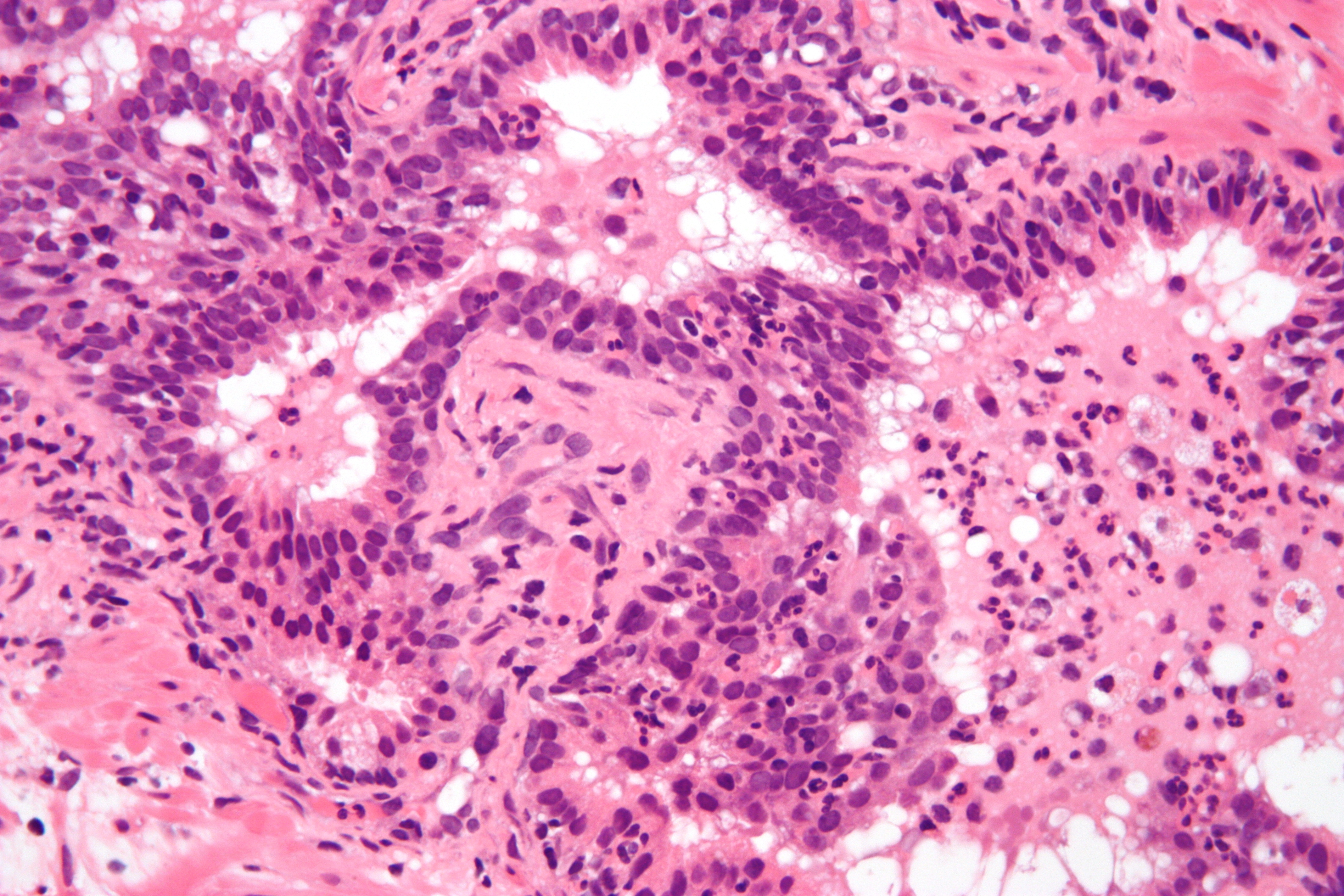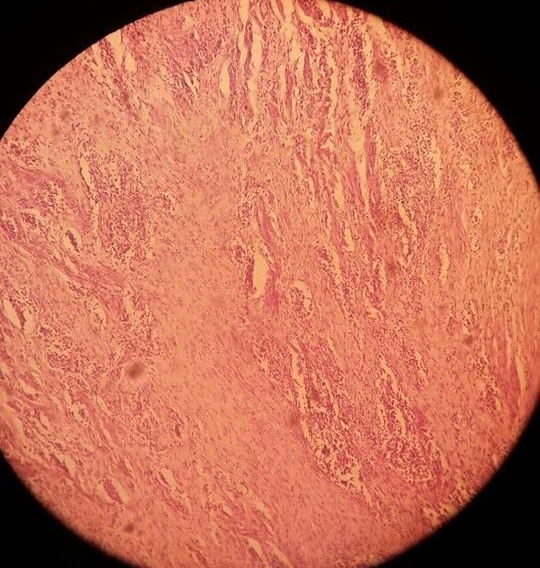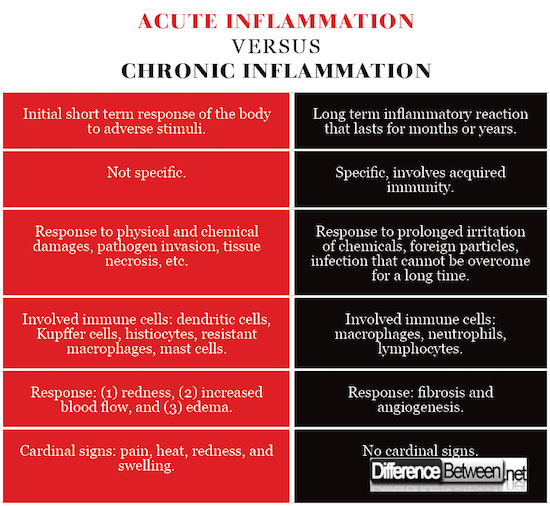Difference Between Acute Inflammation and Chronic Inflammation
Inflammation is part of the protective response of the body tissues to adverse stimuli, like irritants, pathogens, or damaged cells. It involves immune cells, molecular mediators, and blood vessels. The aim of the inflammation is to remove the cause of cell damage, to clear necrotic cells and damaged tissues, and to start tissue recovery.
Depending on the speed of the reaction and the duration, Inflammation is:
- Acute inflammation,
- Chronic inflammation.

What is Acute Inflammation?
Acute inflammation is the early response of the organism to adverse stimuli. It is acquired by an increased transport of leukocytes (especially granulocytes) and plasma from the blood in the damaged tissues.
In acute inflammation develops the so called “triple response of Lewis: (1) redness, (2) increased blood flow, and (3) edema.
The inflammatory response is spread by series of biochemical events. The immune system, the local vascular system, and different cells in the damaged tissue are included in the process.
The acute inflammation process is initiated by immune cells, which are already present in the involved tissue. These are:
- Dendritic cells,
- Kupffer cells,
- Histiocytes,
- Resistant macrophages,
- Mast cells.
When infections, burns or injuries occur, the above listed cells are subject to activation and release inflammatory mediators. This mediators cause the clinical signs of inflammation. Vasodilatation and the resulting increased blood flow cause redness and increased temperature. Increased permeability of the blood vessels leads to exudation of fluid and plasma proteins into the tissue. This results in swelling. Some of the released mediators (e.g. bradykinin) raise the sensitivity to pain (hyperalgesia). The mediators also alter blood vessels to allow migration of leukocytes, primarily macrophages and neutrophils, out of the blood vessels (extravasation) into the tissue. White blood cells migrate along the chemotaxis gradient created by local cells to reach the site of injury.
The acute inflammation is the first line of protection against injury. Acute inflammatory reactions require constant stimulation. Inflammatory mediators have a short lifecycle and are rapidly degraded in tissue. Therefore, acute inflammation begins to desist when the stimulus is removed.

What is Chronic Inflammation?
The chronic inflammation is an inflammatory reaction that lasts for months or years. Most often acute inflammation precedes the chronic, but this is not always the case.
The chronic inflammation can be due to:
- Prolonged irritation of chemicals,
- Foreign particles – dust, surgical thread, etc.,
- Infection by microorganisms that cannot be overcome for a long time by the body – tuberculosis, syphilis, brucellosis.
The following immune cells are involved in the chronic inflammation process:
- Macrophages,
- Neutrophils,
- Lymphocytes.
Depending on the body’s response, the chronic inflammation is:
- Granulomatous inflammation,
- Nongranulomatous inflammation.
The inflammation is granulomatous in case of tuberculosis, toxoplasmosis, mechanical irritation from a foreign body, rheumatoid arthritis, and others. Typical for this type of inflammation is the formation of granuloma, isolating the infected site. The granuloma wall is usually made of fibrous deposits of collagen, and sometimes calcium, and specific cells. In the center are located the causative agent and areas of necrosis.
The nongranulomatous inflammation is characterized by the accumulation of specific inflammatory cells in the damaged location. Granuloma is not formatted. Diffuse necrosis and fibrosis occur. The most common causes of this type of inflammation are chronic viral infections such as chronic hepatitis, chronic autoimmune diseases such as rheumatoid arthritis, chronic atrophic gastritis, allergic inflammation, etc.
The aim of the chronic inflammation is to limit and remove the agent, which cannot be removed by acute response (acute inflammation). Restriction and removal of the agent depend on the reactivity of the immune system.
Difference Between Acute and Chronic Inflammation
-
Definition
Acute Inflammation: Acute inflammation is the early (short term) response of the body to adverse stimuli.
Chronic Inflammation: The chronic inflammation is an inflammatory reaction that lasts for months or years.
-
Specificity
Acute Inflammation: The acute inflammation is not specific.
Chronic Inflammation: The chronic inflammation is specific, it involves acquired immunity.
-
Etiology
Acute inflammation: Acute inflammation is part of the response of the body tissues to physical and chemical damages, pathogen invasion, tissue necrosis, etc.
Chronic inflammation: Chronic inflammation is part of the response of the body tissues to prolonged irritation of chemicals; foreign particles – dust, surgical thread, etc.; infection by microorganisms that cannot be overcome for a long time by the body – tuberculosis, syphilis, brucellosis.
-
Immune cells
Acute inflammation: The following immune cells are involved in the acute inflammation process: dendritic cells, Kupffer cells, histiocytes, resistant macrophages, mast cells.
Chronic inflammation: The following immune cells are involved in the chronic inflammation process: macrophages, neutrophils, lymphocytes.
-
Response
Acute inflammation: In acute inflammation develops the so called “triple response of Lewis: (1) redness, (2) increased blood flow, and (3) edema.
Chronic inflammation: The response in chronic inflammation includes fibrosis and angiogenesis.
-
Cardinal signs
Acute inflammation: The cardinal signs of acute inflammation are pain, heat, redness, and swelling.
Chronic inflammation: The chronic inflammation occurs without cardinal signs.

Summary of Acute versus Chronic Inflammation:
- Inflammation is part of the response of the body tissues to adverse stimuli, such as irritants, pathogens, or damaged cells.
- The function of inflammation is to remove the cause of cell damage, to clear necrotic cells and damaged tissues, and to start tissue recovery.
- Depending on the speed of the reaction and the duration, inflammation is acute or chronic.
- Acute inflammation is the early response of the organism to adverse stimuli, while chronic inflammation is an inflammatory reaction that lasts for months or years. Most often acute inflammation precedes the chronic, but this is not always the case.
- The acute inflammation is not specific, while the chronic inflammation is specific and involves acquired immunity.
- Acute inflammation is a response to physical and chemical damages, pathogen invasion, tissue necrosis, etc. Chronic inflammation is a response to prolonged irritation of chemicals; foreign particles, infection by microorganisms that cannot be overcome for a long time.
- In the acute inflammation are involved dendritic cells, Kupffer cells, histiocytes, resistant macrophages, mast cells. In the chronic inflammation are involved macrophages, neutrophils, lymphocytes.
- The response in acute inflammation includes redness, increased blood flow and edema. The response in chronic inflammation includes fibrosis and angiogenesis.
- The cardinal signs of acute inflammation are pain, heat, redness, swelling. The chronic inflammation occurs without cardinal signs.
- Difference Between Gallstones and Cholecystitis - September 5, 2021
- Difference Between Constipation and Cramping - August 4, 2021
- Difference Between Whole Genome Sequencing and Microarray - May 6, 2021
Search DifferenceBetween.net :
4 Comments
Leave a Response
References :
[0]Image credit: https://commons.wikimedia.org/wiki/File:Chronic_inflammation_slide.jpg#/media/File:Chronic_inflammation_slide.jpg
[1]Image credit: https://commons.wikimedia.org/wiki/File:Acute_inflammation_of_prostate.jpg#/media/File:Acute_inflammation_of_prostate.jpg
[2]Roy. S., D. Bagchi, S. Raychaudhuri. Chronic Inflammation: Molecular Pathophysiology, Nutritional and Therapeutic Interventions. Boca Raton: CRC Press. 2016. Press.
[3]Serhan, C., P. Ward, D. Gilriy (Eds.). Fundamentals of Inflamation. Cambridge: Cambridge University Press. 2010. Print.
[4]Trowbridge, H., R. Emling. Inflammation: A Review of the Process. Hanover Park: Quintessence Publishing Company. 1997. Print.

I want to take advantage of this site on any subject in the field of medicine
Woow this fabulous thank you for helping me in my studies.
I like your explanation on difference of acute and chronic inflammation
I really love these explaination